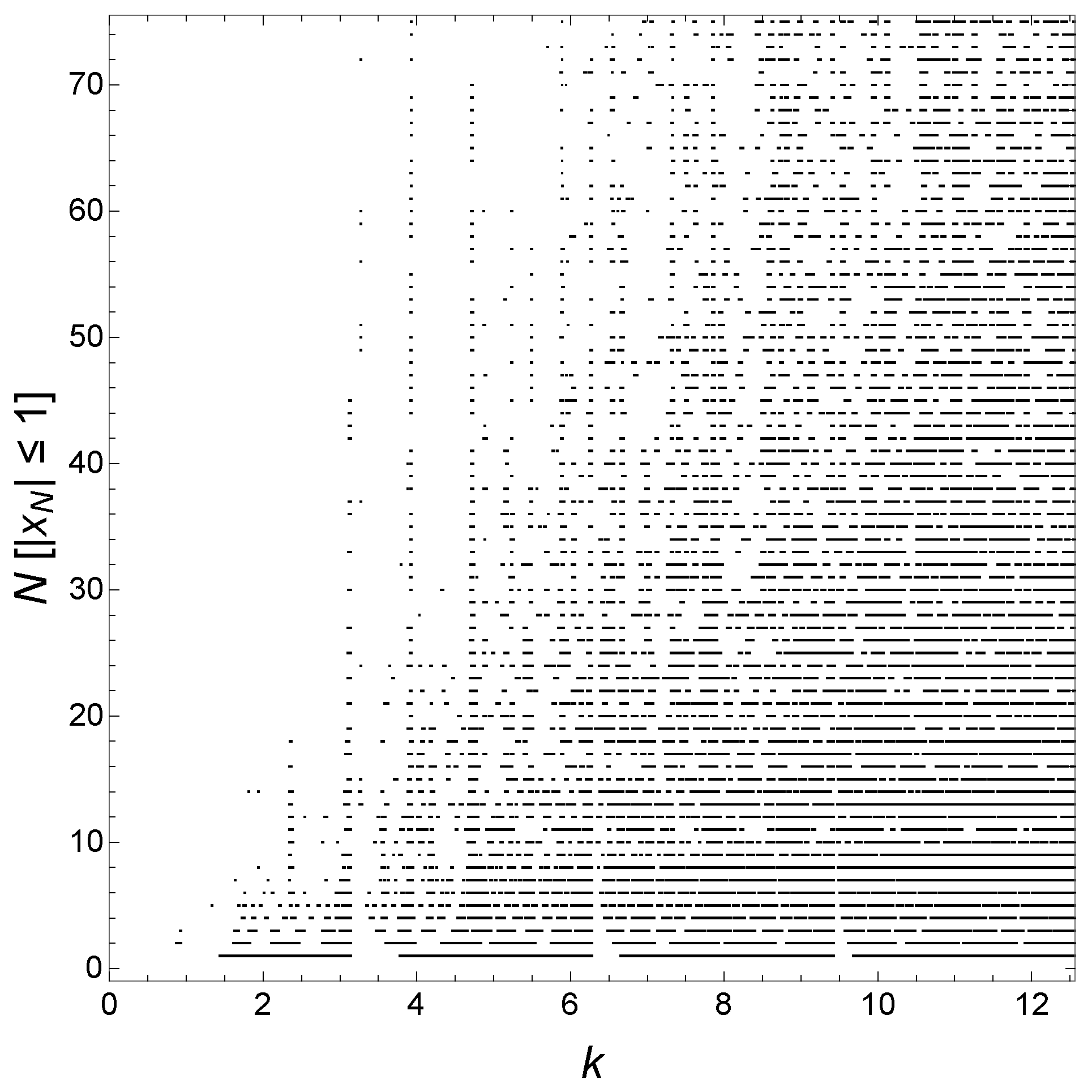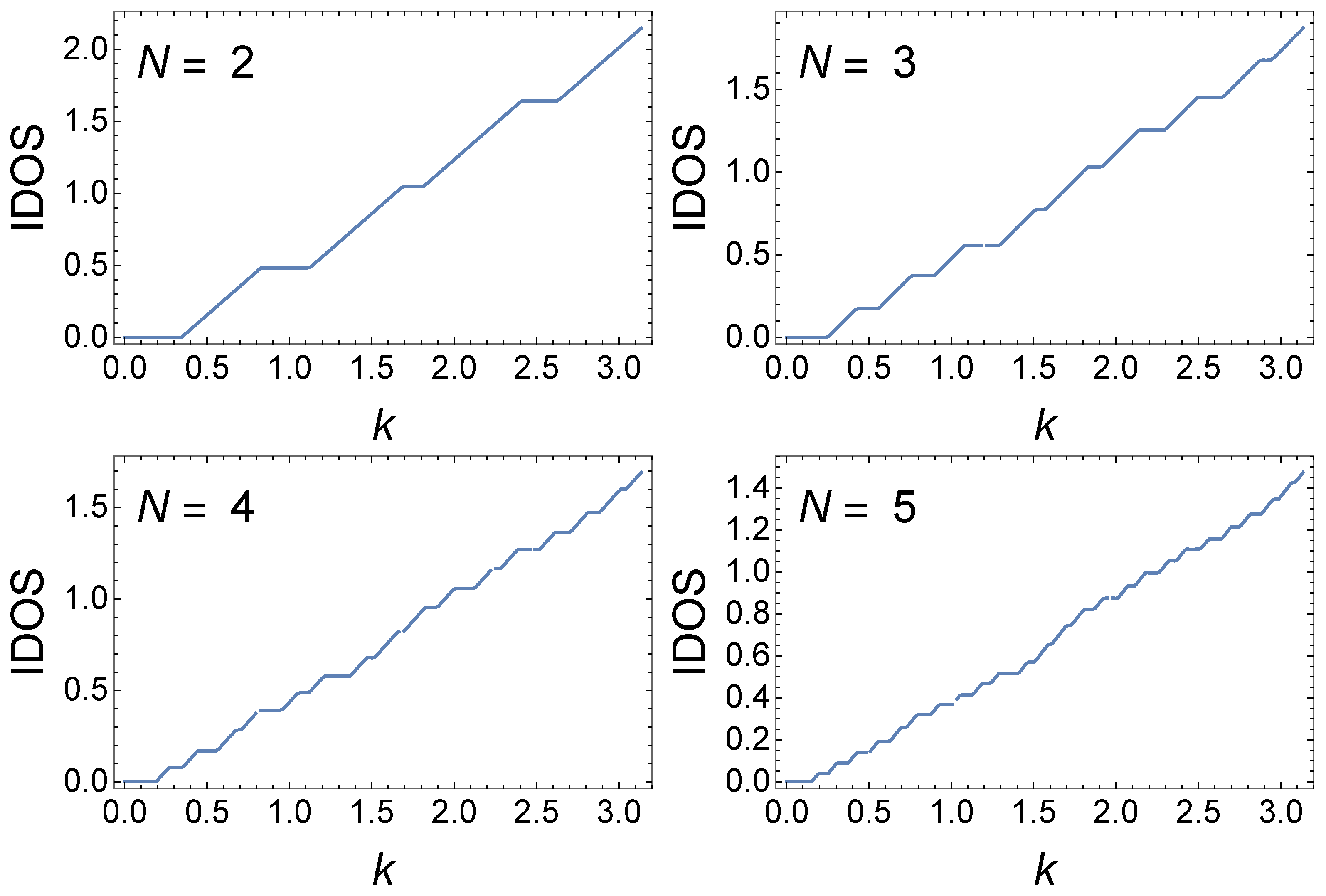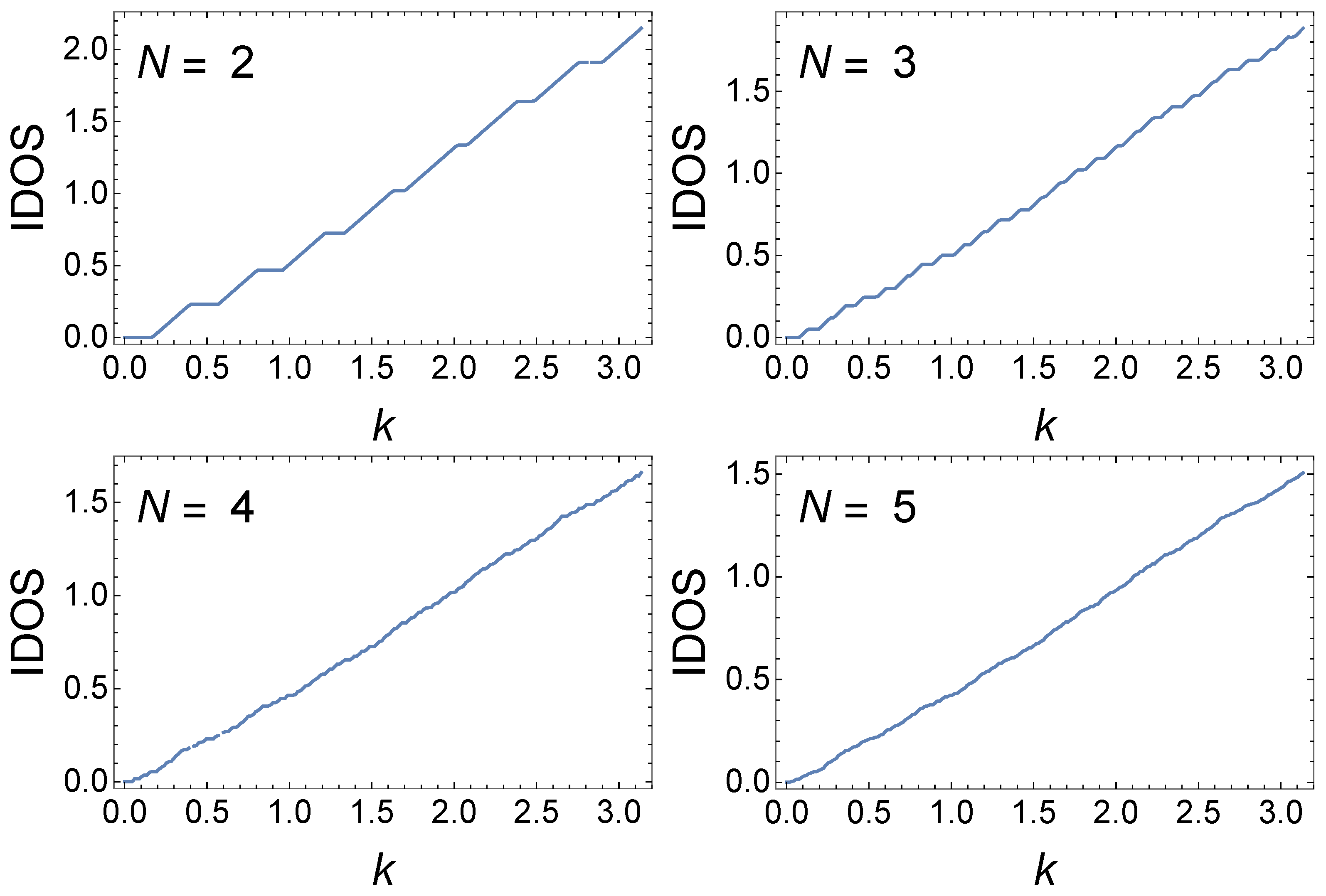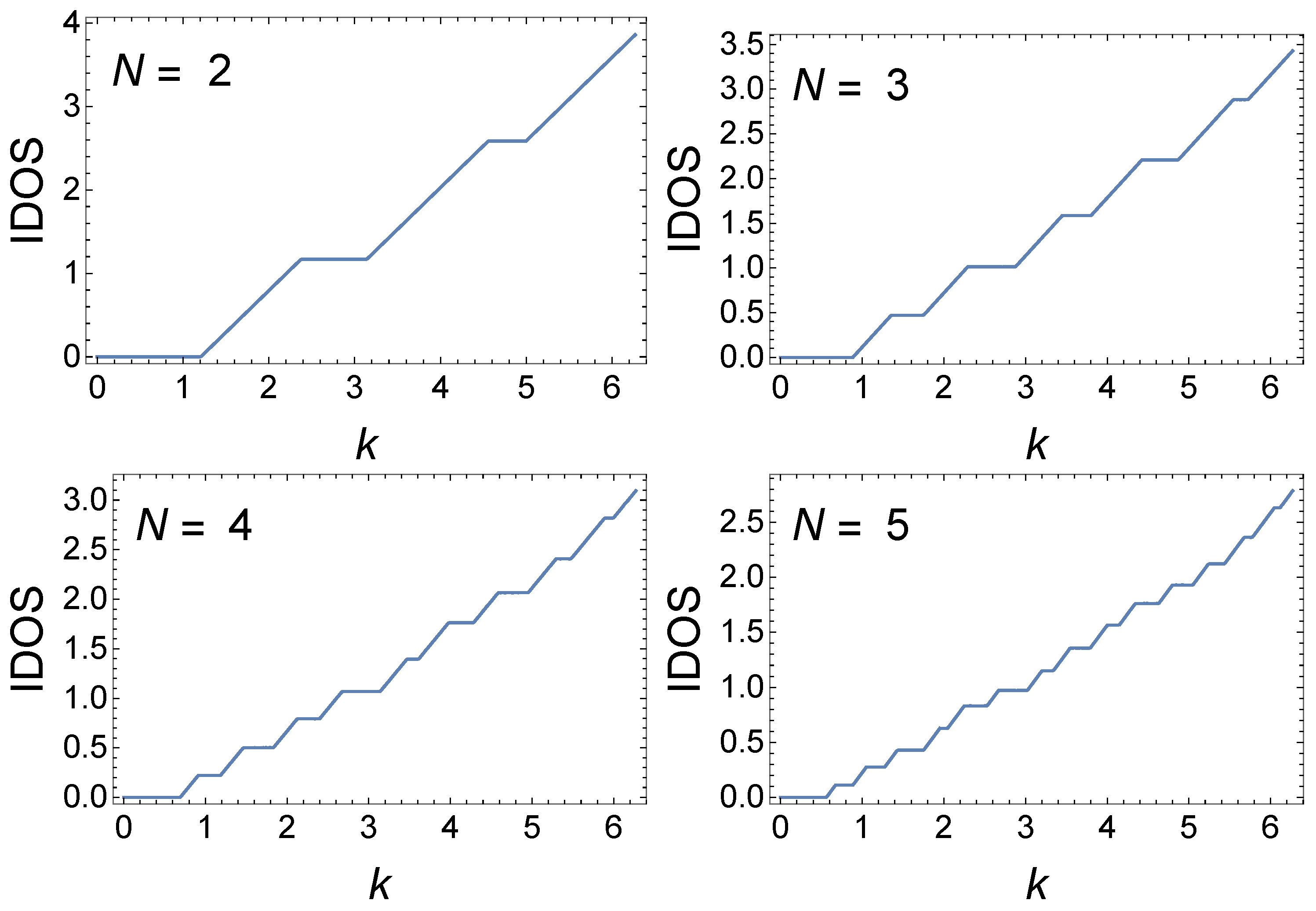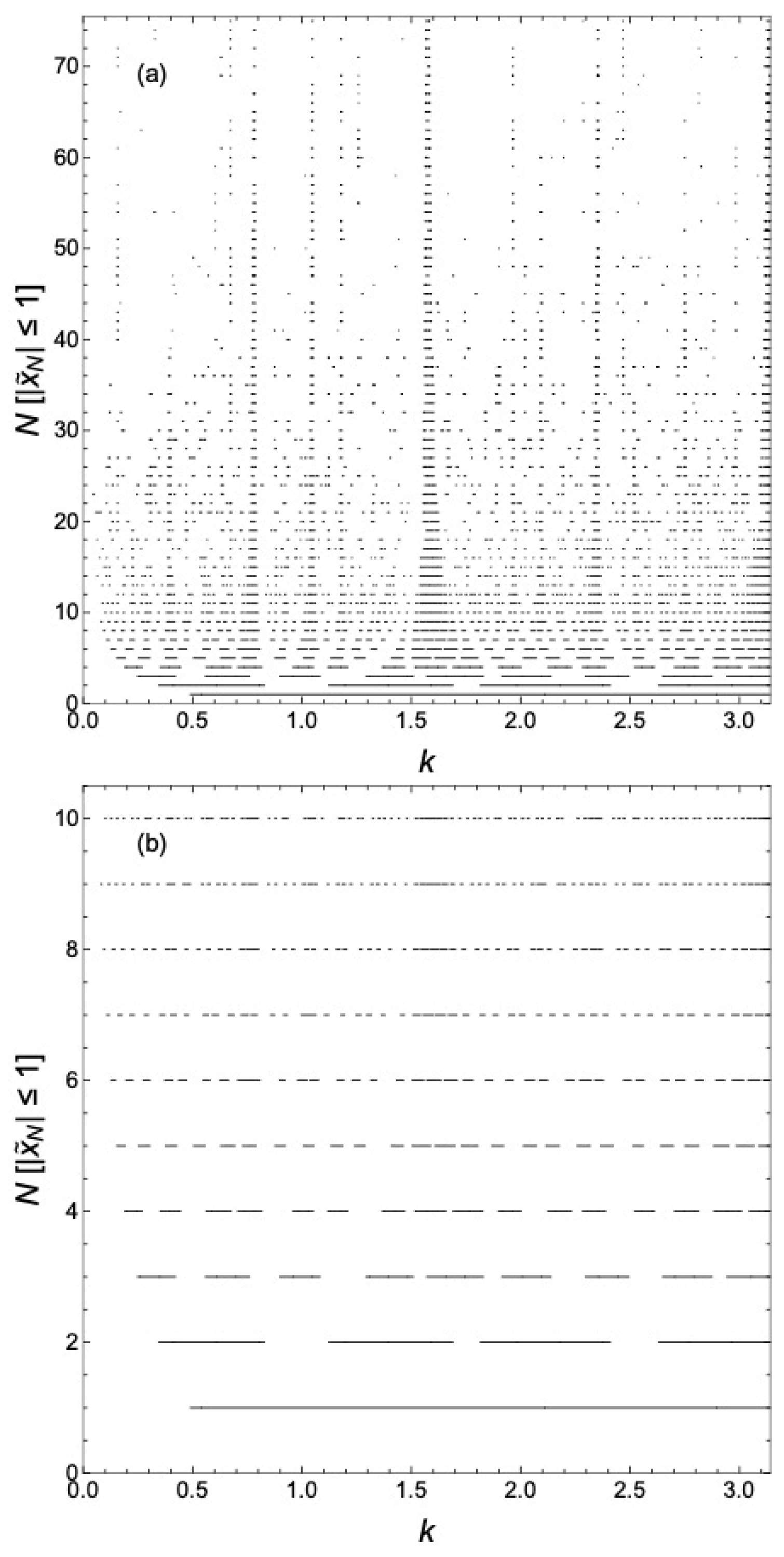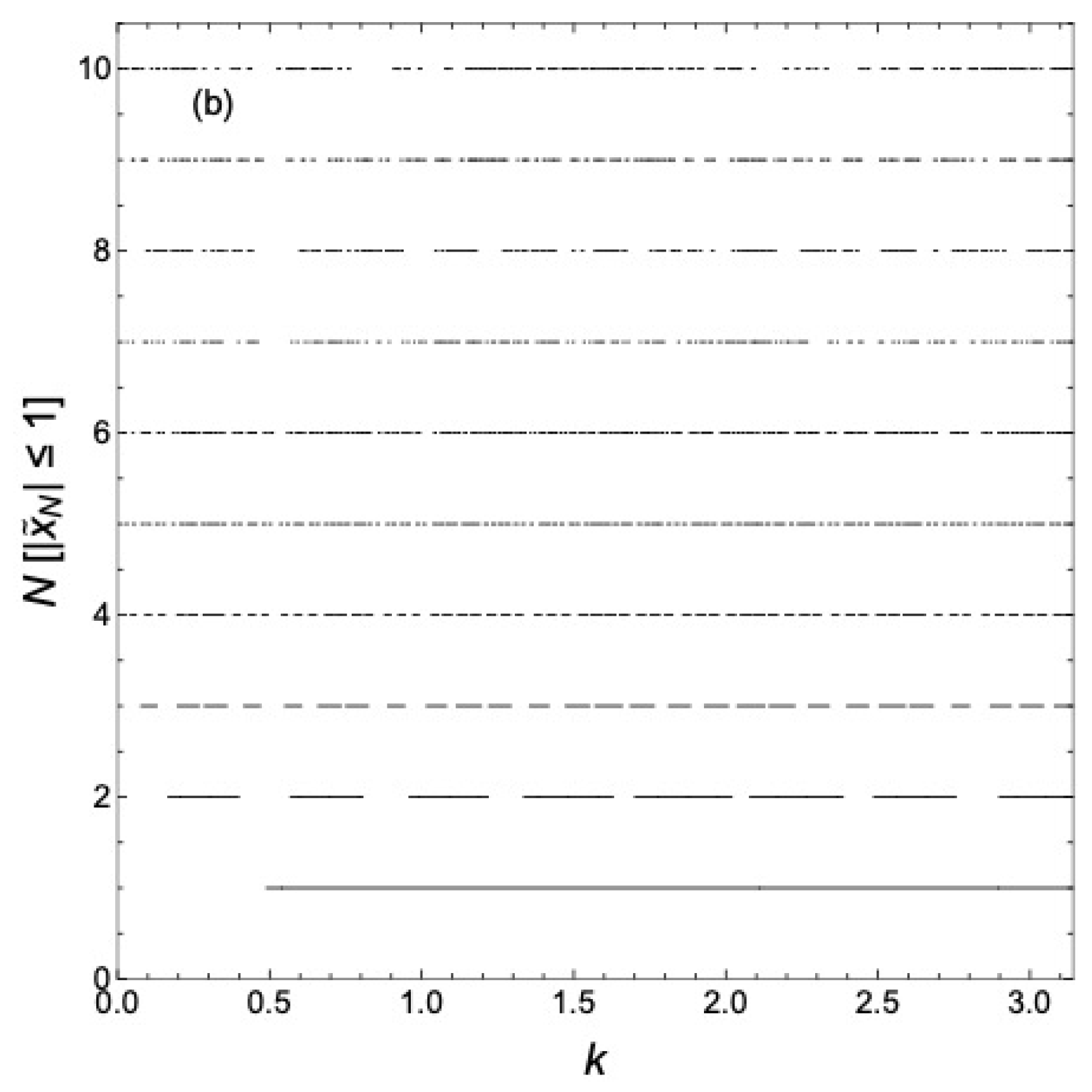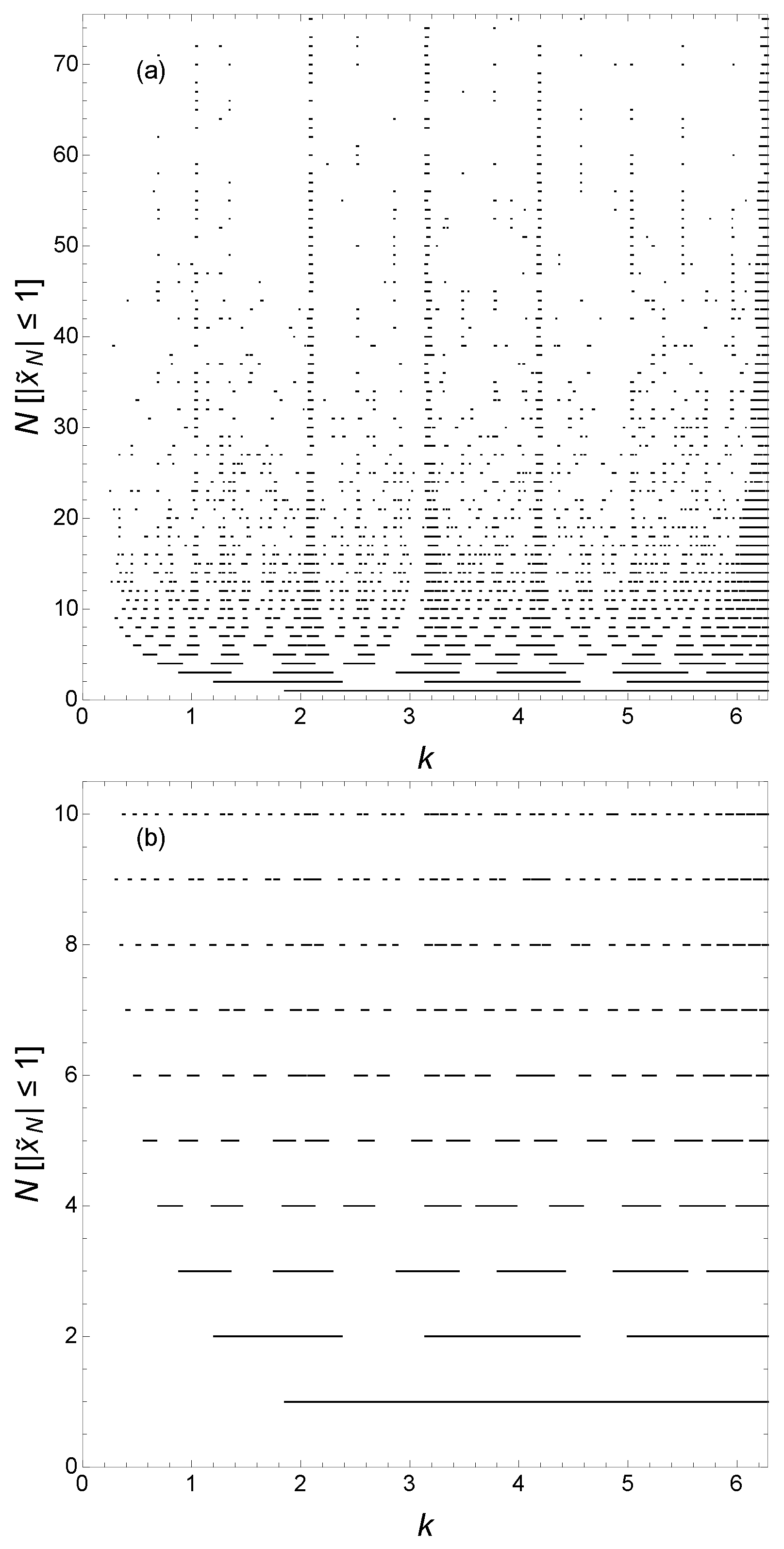1. Introduction
One-dimensional quasiperiodic chains have attracted intense interest [
1,
2,
3,
4] spurred by the discovery of a quasicrystal by Shechtman et al. [
5]. Quasiperiodic systems occupy an intermediate space between periodic and random systems, and they have attracted intense scientific interest for the light they shed on localized and delocalized states in solids. In addition, quasicrystals have begun to attract interest for applications [
6,
7]. They typically have low electrical and thermal conductivity, which makes them of interest for thermal insulation applications [
8]. Their associations with other applications are attributable to their reduced adhesion and tribology properties [
9].
We have been studying a novel class of quasiperiodic systems, namely Gauss chains (GCs). These are one-dimensional quasiperiodic lattices with sites at
, where
represents the order;
,
N represents the number of sites in the GC; and
d represents the underlying lattice constant. GCs and similar structures have also been proposed, as seen in Refs. [
10,
11]. The appellation Gauss chain is due to the importance of Gauss sums [
12] in the theory [
13,
14,
15]. We have worked extensively on order
GCs, viz. the quadratic GC, where we have shown that the structure factor is singular continuous in the
limit and also that the spectrum of delocalized electronic states in the GC exhibits a hierarchy of minibands and gaps [
13,
14,
15]. GCs have interesting relationships with number–theoretic quantities [
13,
14] and thus are of mathematical interest. In addition, the identification of localized, critical, and extended states has been a focus of our work, as this classification impacts the transport properties of these structures. For example, extended states contribute to the conductivity in the large-
N limit, but not delocalized states. We have also studied plasmonic GCs, suggesting possible applications for nanoscale filters [
16].
Related structures that we have studied are
-site generalized quadratic GCs with
, with
, focusing on the fundamental difference between commensurate and incommensurate generalized quadratic GCs, depending on whether
d and
are rationally related or not [
14]. Commensurate generalized quadratic Gauss chains share many characteristics with quadratic GCs, whereas incommensurate generalized quadratic GCs do not. GCs and generalized quadratic GCs are of interest as they are a new class of quasiperiodic chains, but they are also of interest because of the role played by number–theoretic functions in their treatment.
Many of the remarkable properties of GCs follow from a study of their transfer matrix
for an
N-particle chain. Between the Gauss sites at
, a particle’s motion is unconstrained and can be characterized by its wavevector
k in such regions, related to its dimensionless energy
(see below) by
. The transfer matrix
depends on
k and possesses a hidden
k-dependent translational invariance [
14]. That is, for
with
r and
s coprime integers,
, where
m is a positive integer. Thus, for a given
, the GC in effect has a periodicity similar to that of a periodic crystal; however, the GC exhibits different periodicities depending on
s. This hidden translational invariance is shown explicitly below.
Figure 1 shows a schematic diagram of an
N-site GC with
. We have fully and analytically quantified the delocalized states in the
limit in a Kronig–Penney model for this GC [
14,
15]. While we have presented some numerical results for miniband and gap formation for finite GC length as
N increases, little insight was provided at the time that work was published [
14]. It has also been observed that the hierarchy of minibands and gaps becomes more fragmented as
n increases [
17]. Our aim here is to explore miniband and gap formation with increasing
N. This is analogous to how bands form in finite but otherwise periodic crystals as the crystal size increases. Understanding how minibands and gaps form in GCs may, in the future, enable a rigorous classification of the minibands and allow for a better understanding of the formation of extended states as
. Here, we carry out numerical work showing that the strongly fragmented nature is connected with the rapid increase in the number of minibands and gaps with increasing
n. The behaviors for various values of
n are also investigated.
We also formulate a bottom-up real-space renormalization-group (RSRG) approach applicable to a case where
, complementary to that used in Ref. [
18]. There, however, we applied a top-down approach to analyze the electronic structure of long yet finite-length GCs (in a nearest-neighbor tight-binding model). By “bottom-up”, we mean that the
N-site GC half-trace
of the transfer matrix
is built up by an inflation rule starting with
; by a top-down approach, we ultimately reduce the
N-site transfer matrix to a one-site transfer matrix with renormalized parameters by means of a deflation rule. Studying
is key to understanding the localization properties of the states at
. For
, the state is localized; for
, it is extended; and for
, it is critical. This is discussed further below. Here, we devise an iterative relation for the half-trace
of the transfer matrix
, as
N is incremented, and use this to characterize the minibands and gaps observed. We do not use the RSRG approach for the numerics; however, the approach may be connected to why the case
and the generalized quadratic GC we study might be special in leading to a clear hierarchy of minibands and gaps. This is apparently the only case for which our RSRG approach works, perhaps reflecting the special symmetry of this specific case. The RSRG approach may also provide insight into the self-similar properties of the GC and its electronic properties.
The remainder of this paper is organized as follows: In
Section 2, we review the theoretical approach that leads to a transfer matrix
for the GC.
Section 3 outlines how we can obtain an iterative relation for the half-trace
of
for the GC of length
N.
Section 4 presents numerical results, while
Section 5 gives our conclusions.
2. Methods
2.1. Setting Up the Problem
We employ a Kronig–Penney model as the basis of a transfer matrix approach [
19]. The effective-mass Hamiltonian for an electron in an
N-site GC is
where
is the effective mass, and
is the dimensionless strength of the potential at the Gauss sites. Site
has half the weight of the others so that the Fourier transform of
is proportional to a Jacobi theta function [
13] for
. In any case, this has little effect on the results. For
and
, we employ free-particle boundary conditions. We dispense with excess parameters by defining the normalized Hamiltonian
. We then solve the Schödinger equation
, where
is an eigenvalue (dimensionless) of
and
is the corresponding eigenfunction.
2.2. Transfer Matrix
The transfer matrix
for the
N-site GC relates the left- and right-going travelling-wave components of the free-particle state in
to those in
. In this study, we are mainly interested in delocalized states. We define
;
k to be the wavevector of an eigenfunction of
between successive Gauss sites where the electron behaves as a free particle. Without loss of generality, we take
and associate
with a dimensionless wavevector. We use the transfer matrix approach discussed in Ref. [
20], also called the
M-matrix in Ref. [
19]. Consider the wavefunction near site
for some
. For
, the wavefunction is of the form
, where
and
unknown coefficients. Based on the continuity of
at
and by integrating the Schrödinger equation from
to
for
, we have
which can be rearranged in matrix form to obtain
with
M is the transfer matrix across Gauss sites other than , while is the transfer matrix across sites and .
The transfer matrix for free propagation between successive Gauss sites
and
is
Finally, the transfer matrix of the
N-site GC is as we showed in Ref. [
13]
Notice that , from which the hidden k-dependent translational invariance follows for m, a positive integer.
Since
M,
, and
are unimodular, so is
. This means the eigenvalues
of
(not of
) satisfy
. Since the trace of a matrix is invariant under similarity transformations, the half-trace
of
satisfies
[
21]. Delocalized states (extended and critical) then correspond to energies
with
, for which
. The
k-dependence of
is understood in these and similar expressions even if not explicitly written. It would be useful to plot quantities related to
, where
is the Iverson bracket, i.e.,
if proposition
P is true, and
if
P is false.
A few comments on the symmetry properties of are in order. It is useful to make an approximation whereby we neglect the k-dependence of M and but retain the k-dependence of . This not only allows us to facilitate numerical computation but also enables us to highlight the basic characteristics of the miniband and gap formation, which might be obscured by including this k-dependence. Consider , where for . With regard to the approximation just stated, we can approximate in that interval, neglecting the k-dependence of and, hence, that of M and . Note that the approximation improves as m increases. We label the transfer matrix under this approximation as and further define . is periodic in k with period for , and thus, we will provide plots for . Consequently, we set to be constant in the sequel, choosing . Note that making the replacements and in the modified transfer matrix takes to , thus changing the sign of , preserving the solutions of . This approximation is not terribly severe, and it is easily relaxed for numerical computations. We employ it, however, because it emphasizes the structure of the miniband and gap formation as N increases.
In the next section, we discuss how to compute
or
without explicitly calculating the matrix product in Equation (
7) for the
case.
2.3. Real-Space Renormalization Group and Recurrence Relation for
In this section, we will use a self-similar property of the GC for
to obtain an iterative relation for
or
, thus precluding the necessity of explicitly computing the matrix product in Equation (
7). We do not use the RSRG for the numerical computations; however, the fact that the approach works only for
is attributable to the self-similarity that is also only exhibited for this case. We have not found a way to apply this approach to other values of
n. A top-down version of the approach is discussed in Ref. [
18]. Here, we want to start with
and explore the delocalized-state spectrum as
N is incremented in unit intervals.
To proceed, let us denote the
-th entries of
M and
as
and
, respectively. We will later restore the values of the matrix elements given in Equation (
5). Note that the following inflation rule can be used to generate the transfer matrix for an
-site GC from an
N-site chain:
For example, after one application of this rule to
in Equation (
7), we have
We define the equivalence class of transfer matrices obtained by cyclic permutations of the constituent factors since two such transfer matrices have the same half-trace
. If matrices
A and
B are in the same equivalence class, we say
A is equivalent to
B and write
. That is, inasmuch as we are concerned with the half-trace
of the transfer matrix
, we will cyclically permute the final factor of
to the front of the product to give
We can abbreviate this inflation rule as follows:
By computing
and
in terms of the
and
, the rules (
8) and (
9) are equivalent to making the following replacements in
to obtain
:
Thus, in terms of the parameters, we can write down the iterative relation
with the initial condition
The expressions above also hold for . This bottom-up RSRG approach obviates the need to explicitly compute transfer matrices. To conclude this section, the iterative approach just discussed works for . We have not seen how to generalize the technique to .
4. Discussion
It is easier to visualize the continuing evolution with
N by plotting
for various
N in the same plot for each case considered above, as we will now show. That is, we neglect the
k-dependence of
to better bring out the structure of the minibands and gaps and better illustrate their evolution as
N increases, in contrast to what is shown, say, in
Figure 2. A global view of the delocalized states as a function of
k over one period in
k for various
N is shown in
Figure 6a for
. That is, what is plotted is
as functions of
k for various
N. We see what is apparently a self-similar hierarchy of minibands and gaps developing as
N increases. The number of minibands in one period in
is observed to be
. A particularly pronounced miniband occurs near
, and this miniband persists as
N increases. We have not, however, been able to classify the minibands and gaps as reviewed in Ref. [
4] for Fibonacci chains. There is no known analogous gap-labeling theorem [
22,
23,
24] for GCs.
Figure 7 shows
as functions of
k for various
N for the case
, viz.
, for which
, again with
. The energy eigenvalues are periodic in
k with period
; however, the term
in
also produces features on the scale of changes in
k of
as
is even. In
Figure 7a, we can see these underlying features giving an overall fragmented appearance to the hierarchy of minibands and gaps. The fragmentation of the delocalized states for cases
has been documented in Ref. [
17].
One can additionally consider GCs for which
is not simply a power of
j, but instead a polynomial with commensurate coefficients, i.e., a commensurate generalized quadratic GC. (For the incommensurate case, the electronic structure is not periodic in
k and is highly fragmented [
14].)
Figure 8 shows
as functions of
k for various
N for
. We also replace
with
in
. In this case, the electronic structure is periodic in
k with period
and exhibits a clear hierarchy of minibands and gaps, as seen in
Figure 8. Similar to the case of
treated above, we see the development of a clear hierarchy of minibands and gaps—far clearer than for any GC with
that we have studied and, indeed, clearer than for
itself. Here, we see the trivially delocalized states at
, the factor of 2 due to the
in
. Noting that the range of
k on the horizontal axis is
, in contrast to
Figure 6, we actually see similar, but not identical, structures within a range of
in the two figures. The connection between these two cases is commented upon later.
In fact, it would appear that
and
are indeed special cases, as it would appear that only for these can we have a
j-independent inflation rule similar to Equations (
8) and (
9). As we now show, these two GCs have transfer matrices sharing the same underlying structure, and thus, they have the same hidden translational invariance. To proceed, for
, however, instead of rule (
8) and (
9), we develop new rules, as shown below, that, as we shall see, are closely related. Note that the transfer matrix in this case for the
Nth generation GC is
Now, define the inflation rules
The application of these rules to
gives
Note that the transfer matrix in Equation (
25) for this GC has the same symmetry as the GC for
. Make the replacements
,
, and
in Equation (
25) and recover a transfer matrix with the structure of that for the
GC in Equation (
7). Note that, however, the actual
k-dependence of the transfer matrices in these two cases are different.
5. Conclusions
In this work, we have investigated the evolution of a hierarchy of minibands and gaps with increasing N in GCs. The work is empirical in the sense that we present numerical calculations without being able to rigorously identify the underlying physics in all cases. Hopefully, future work will provide some insight into the underlying physics. Nonetheless, based on what is presented here, we can make a number of statements based on our results.
We numerically compute the delocalized electronic states as a function of chain length
N to see the development of a hierarchy of minibands and gaps. The cases with the most visually evident structure appear to be for the GC and the generalized quadratic GC for
. We observe the formation of minibands and gaps that appear to persist for high values of
N; as
N increases, most states appear to become localized, though some states continue to be delocalized. The integrated density of states shows a region of enhanced value near
for the GC with
, as well as signs of self-similarity. Based on rigorous arguments developed elsewhere [
14,
15], perspective delocalized states have wavevectors between Gauss sites
, where
r and
s are coprime integers. The spectrum of delocalized states is singular continuous in the
limit [
14], consistent with what is noted here. This is a consequence of the
k-dependent translational invariance of the transfer matrix.
In contrast, for (only results for are presented here), the structure seen in the evolution of the minibands and gaps with increasing N is visually not evident compared with that for . We find that the transfer matrix exhibits a k-dependent translational invariance for all GCs; however, the origin of the difference between the GC and the generalized quadratic GC studied here and GCs with can be hinted at by a RSRG technique whereby the transfer matrix for an -site GC is generated from the transfer matrix for an N-site GC. The iterative, bottom-up RSRG approach for computing the half-trace of the transfer matrix is presented for an N-site quadratic GC and for the specific generalized quadratic GC . The approach, which does not work for or any other case, reveals a self-similar structure to the transfer matrix for the GC, as well as for the generalized quadratic GC.

